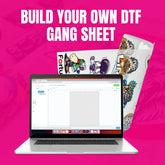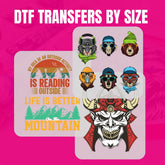How to Design Custom DTF Transfers for Maximum Quality?
Custom DTF transfers call for knowledge of the printing process, the correct design approaches, and attention to detail. The objective is always the same—high-quality, vivid prints that last—regardless of your intended use—personal or commercial. DTF transfers are ready to press for either. How can you guarantee that your DTF transfer sheets create sharp, detailed designs? All the difference is in knowing the design process, selecting the optimal parameters, and using the correct materials.
Understanding the Basics of Custom DTF Transfers
Understanding DTF heat transfer helps one better approach the design process. The technique consists of printing a design onto a DTF gang sheet with specific inks, applying adhesive powder, and then transferring the picture onto the cloth by heat and pressure. Custom DTF transfers, unlike conventional techniques, let many fabrics—including cotton, polyester, and blends—have full-color, high-detail prints.
Step 1: Choosing the Right Design Software
Ensuring your DTF transfers ready to press of the best quality depends critically on your choice of design tool. Expert applications such as Adobe Photoshop and Illustrator provide exact control over color, resolution, and effects. Another often used tool for vector-based design is CorelDRAW, which preserves print crisp edges. Canva can be a user-friendly substitute for beginners even though it lacks the sophisticated tools required for difficult designs.
Step 2: Designing for Maximum Quality
Custom DTF transfers' success relies on the degree of design quality. High-resolution photographs guarantee clarity; hence, always utilize files at least 300 DPI to prevent pixelation. For darker materials in particular, adding a white under the base layer can improve visibility. Choosing colors also counts; utilizing CMYK guarantees correct color reproduction on printing. Careful adjustment of transparency parameters helps to avoid any undesired backdrop in the produced print.
Step 3: Setting Up the File for Printing
Once your design is ready to print on DTF transfer sheets, it needs to be formatted correctly. The file ought to be kept transparently in a PNG or TIFF format. Before storage, flattening layers helps preserve color constancy and prevent any unanticipated variations while printing. By fitting various transfers on a single sheet, you can optimize productivity by aligning several designs onto a DTF gang sheet and lowering material waste.
Step 4: Optimizing Text and Effects
Custom DTF transfers' text elements have to be readable and clear. Bold fonts work best since they keep sharp even under heat pressing. Though used sparingly to avoid clutter, effects like shadows and outlines can give designs depth. Ensure the gradients you add are smooth to prevent banding in the finished print. Once copied into cloth, proper spacing between parts helps preserve design clarity once copied into cloth.
Step 5: Preparing for the Heat Press Process
Once produced, the DTF transfer sheets must be heat-pressed to cling to the cloth properly. The correct DTF heat transfer settings—usually 320°F to 330°F with medium to high pressure—guarantee a smooth, long-lasting finish. Though it varies, pressing time normally runs between 10 and 15 seconds. Before peeling, letting the transfer cool helps increase durability.
Conclusion
Custom DTF transfers require careful planning, excellent artwork, and correct preparation. From choosing the correct program to adjusting file parameters and knowing heat press processes, every action counts toward producing the greatest results. Following these guidelines will help guarantee professional-quality prints whether you are making DTF transfers ready for usage in a company or personal space. To explore high-quality DTF transfer sheets and materials, visit DTF Transfer Art today!
- bulk dtf transfers
- bulk printing
- cost-efficient printing
- custom apparel printing
- Custom clothing printing
- custom gangsheet
- Custom Gangsheets
- custom heat transfers
- custom prints
- decal production
- decal transfer
- decal transfers
- Design preparation
- Digital printing
- Direct-to-Film Transfer
- dtf business
- DTF gangsheet
- DTF Heat Press
- dtf print shop
- DTF Printing
- dtf transfer
- dtf transfer art
- dtf transfer film
- dtf transfer instructions
- dtf transfer paper
- dtf transfer printer
- dtf transfer sheets
- dtf transfers
- dtf transfers near me
- dtf transfers ready to press
- dtf transfers wholesale
- DTF vs Screen Printing
- DTF vs Vinyl
- DTF vs. iron-on
- dtf wholesale
- gangsheet printing
- heat press printing
- heat transfer decals
- heat transfer method
- heat transfer printing
- hoodie printing
- hot peel DTF
- iron-on decals
- model decals
- print on demand
- Printing companies
- Printing methods
- Quality printing
- Screen printing
- sticker printing
- Sublimation printing
- t shirt printing
- Textile printing
- Transfer printing
- vinyl decals
- what is dtf transfer






